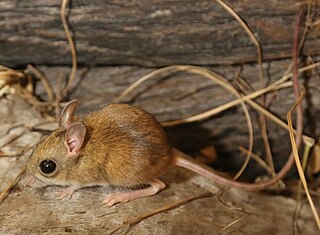
Gould's mouse, also known as the Shark Bay mouse and djoongari in the Pintupi and Luritja languages, is a species of rodent in the murid family. Once ranging throughout Australia from Western Australia to New South Wales, its range has since been reduced to five islands off the coast of Western Australia.

Maclear's rat is an extinct large rat endemic to Christmas Island in the Indian Ocean. It was one of two species of rat native to Christmas Island, alongside the bulldog rat. Abundant, unfamiliar with and seemingly unafraid of humans, large numbers of the creatures emerged and foraged in all directions at night. Making querulous squeaks, the rats entered the Challenger expedition's tents and shelters in 1886, ran over sleepers, and upset everything in the search and fight for food. Maclear's rat might have been responsible for keeping the population of the Christmas Island red crab in check, as recent numbers of the crab are greater than in the past. It is thought that black rats inadvertently introduced by the expedition infected the Maclear's rats with a disease, which in turn could have contributed to the species' decline. The last recorded sighting was in 1903, although it is possible that Maclear's rats hybridized with black rats. A hard tick, described as an ectoparasite of Maclear's rat, is also thought to be extinct.

The bulldog rat is an extinct species of rat formerly endemic to Christmas Island in the Indian Ocean. It was one of two rats endemic to Christmas Island, alongside Maclear's rat.

The spectacled hare-wallaby is a species of macropod found in Australia and New Guinea. In Australia, a small sub-population is found on Barrow Island, while the mainland type is widespread, though in decline, across northern regions of the country.
This article is a list of biological species, subspecies, and evolutionary significant units that are known to have become extinct during the Holocene, the current geologic epoch, ordered by their known or approximate date of disappearance from oldest to most recent.

The pale field rat is a small rat endemic to Australia. It is a nocturnal and herbivorous rodent that resides throughout the day in shallow burrows made in loose sand. Once widespread, the range has become greatly reduced and it is restricted to the grasslands, sedges, and cane-fields at the north and east of the continent. The fur is an attractive yellow-brown colour, with grey or cream at the underside. This medium-sized rat has a tail shorter than its body.

The northern hopping mouse is a species of rodent in the family Muridae. It is found only in coastal northern Australia, from Arnhem Land to the Cobourg Peninsula.

The smoky mouse is a species of rodent in the family Muridae native to southeastern Australia. It was first described in 1934 and its species name is Latin for "smoky". As its name suggests, it is a grey-furred mouse, darker grey above and paler smoky grey below. Mice from the Grampians are larger and a darker more slate-grey above. It has a black eye-ring and dark grey muzzle. The feet are light pink, and the ears a grey-pink. The tail is longer than the mouse's body, and is pink with a brownish stripe along the top. Mice from east of Melbourne average around 35 grams and have 107 mm long bodies with 116 mm long tails, while those from the Grampians are around 65 grams and have 122 mm long bodies with 132 mm long tails.
The dusky field rat, also known as the canefield rat, is a species of rodent in the family Muridae. It is found in Australia, Indonesia, and Papua New Guinea. In Australia it is found in northern Queensland and along the east coast as far south as Shoalwater Bay, where it is plentiful, and on South West Island in the Sir Edward Pellew Group off the Northern Territory, where it is considered a threatened species.
The Arnhem Land rock rat also known as the Arnhem rock-rat and by the Indigenous Australian name of kodjperr is a species of rodent in the family Muridae. It is found only in the Top End Region of the Northern Territory in Australia.

The black-eared flying fox, species Pteropus melanotus, is a bat of the family Pteropodidae (megabats). Also known as Blyth's flying fox, it is found on the Andaman Islands and Nicobar Islands (India), and in Sumatra (Indonesia). A population on Christmas Island, which is critically endangered, has been placed as a subspecies of this population. The conservation and taxonomic status of that population was later re-established as a distinct species, the Christmas Island fruit-bat Pteropus natalis.

The Christmas Island shrew, also known as the Christmas Island musk-shrew is an extremely rare or possibly extinct shrew from Christmas Island. It was variously placed as subspecies of the Asian gray shrew or the Southeast Asian shrew, but morphological differences and the large distance between the species indicate that it is an entirely distinct species.

The Christmas Island flying fox or Christmas Island fruit bat, as the name suggests, is a flying fox endemic to Christmas Island. It is unclear if it should be considered a distinct species, or a subspecies of the black-eared flying fox. It may descend from a population of island flying foxes from Pulau Panjang near Java.





























